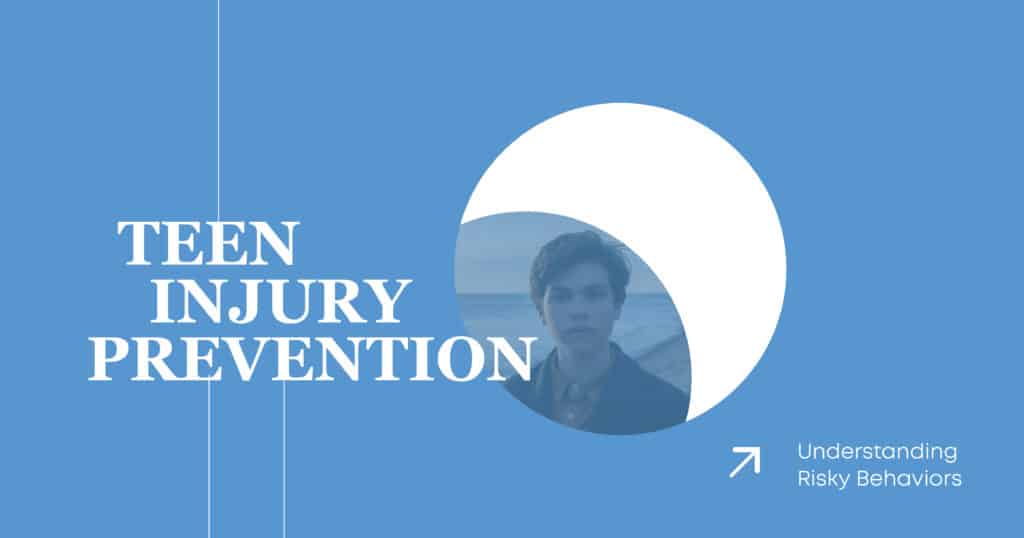It is crucial to know all the teen injury prevention techniques to help keep them free from unnecessary harm. Parents, guardians, and teachers need to understand them. During teenage life, adolescents mainly engage in adolescent-risk behavior, which can result in accidents, injury, or even death. However, with exemplary commitment and education, we can minimize risk-taking behavior and encourage safer adolescent choices.
A brief description of risk-taking behavior, the determinants and motivations that affect whether a person participates in risk-taking behavior, and the mechanisms through which effective youth safety strategies may modify behavior accordingly.
What Is Risky Behavior?
Our first step in preventing injuries during the teenage years is to define risky behavior. Risky behavior is any activity that may indicate an introduction to activities that would make the individual or another person susceptible to injury or even death. In teenagers, these behaviors tend to be exhibited as curiosity combined with peer pressure and an undeveloped sense of consequence.
Common examples of risky behavior among teenagers include.
- Reckless Driving. Speeding, distracted driving, and driving under the influence of alcohol or drugs are all major contributors to accidents.
- Substance Abuse. Experimentation with alcohol, cigarettes, and drugs can lead to addiction, accidents, or long-term health issues.
- Unsafe Sexual Practices. Teenagers may engage in unprotected sex or risky sexual behavior due to a lack of education or peer influence.
- Extreme Physical Activities. Some teens engage in dangerous physical stunts, sports, or thrill-seeking behaviors without fully considering the risks involved.
- Self-Harm and Risky Online Behavior. Cyberbullying and online harassment can also lead to significant emotional harm, often prompting teens to take drastic, harmful actions.
In the area of prevention, actions surrounding such activities pose hazardous behavior to adolescents and the risk for injury mental health problems, or damage that will last throughout their lives. Teen injury prevention involves making teenagers understand the repercussions of their actions.
Hillside Horizon
Adolescent Risk-Taking Behavior Statistics
Statistics showing risky behavior among young people is quite upsetting. However, according to the Centers for Disease Control and Prevention (CDC), the leading cause of death among teens in the United States is unintentional injuries that occur in the most common cases due to motor vehicle crashes, drownings and falls. Moreover, risky behavior in adolescents contributes significantly to this injury.

For example:
- Motor Vehicle Accidents. Every year, almost 2000 teenage lives are claimed by car accidents, of which the maximum deaths are caused by reckless driving and absence of seatbelts or driving under the influence.
- Substance-Related Incidents. It’s shameful that, while a teenager indulges in an alcoholic drink or uses a drug illicitly, most of the injuries or accidents happen as a result.
- Suicide And Self-Harm. Suicide has been recognized as the second leading cause of death in adolescents because, most of the time, teens resort to self-harm. Mostly, they do so due to mental health issues and emotional distress.
Youth injury prevention tips, the more numbers we receive, the better we can handle these things and develop proper solutions to prevent injury and harm.
Factors Causing Risky Behavior Among Teenagers
It is time to study the different factors influencing adolescent’s risky behavior. Understanding some of those reasons can greatly contribute to creating effective adolescent safety measures.
- Biological and Brain Development
Adolescence is a time when the brain develops further, especially in areas that control impulses, decision-making, and understanding long-term consequences. Because of this incapacity for fully developed judgment, a teen is likely to take more risks than an adult.
Teens tend to have a brain that favors immediate gratification over long-term consequences, which might make them more susceptible to risky behaviors, such as using drugs or alcohol, unsafe driving, or jumping off buildings.
- Peer Pressure and Social Influence
Peer pressure is a chief contributor to hazardous teen undertakings. They are at an age of association with friends, and gaining social acceptance is what they deem essential. This would cause them to do activities they would usually refuse to do, which would be more pronounced if a peer prompted the thing.
Whether it is risk-taking through alcohol or drugs, extreme physical stunts, or even unsafe online activities, teenagers commonly decide under social influence and not by their better judgment.
- Lack of Awareness and Education
In most cases, teenagers do not have clear ideas about the risks their behavior puts them at. They might think they are invincible or “nothing will happen to them.” Believing in this kind of invulnerability encourages unsafe behaviors without considering the long-term consequences. So, educating people on the importance of risk avoidance in teens will be essential for changing these ideas.
- Family Dynamics and Parenting Styles
The environment in which one matures during adolescence can affect the risks that an adolescent engages in. For example, teens with poorer family communication, support for their emotions, or a history of substance abuse would be more likely to engage in such activities themselves.
On the other hand, a good family environment, where teens feel supported and understood, can significantly reduce their involvement in risk-taking behavior.
Hillside Horizon
Strategies to Reduce Risk-Taking Behavior
Take an active role, as parents, educators, and caregivers, in engaging teens and reducing their involvement in adolescent risky behavior. Here are some examples of the strategies you can implement:
Good Parent-Child Relationship
Build an honest, open relationship with your teen as the bedrock of successful intervention strategies for risky behavior. When parents sincerely care for their teenagers, they need to listen to, believe in, and trust the guidance they receive from them:
- Focus on Communication. Encourage your teen to communicate as much as possible about their life’s various experiences, challenges, and concerns.
- Be Supportive and Non-judgmental. That would mean listening without jumping to conclusions or offering solutions immediately.
- Show Empathy. Acknowledgment that your teen is under pressure and, when necessary, lend an ear.
A good relationship with the child will impact their decisions concerning youth safety strategies, contributing to some healthier, safer decisions.

Keeping an Eye Without Being Intrusive
Everyone knows teenagers need to be given space, but safety in the long run also means knowing what’s happening with your teens. It’s not spying, but it’s just being interested in the things that matter in their lives.
- For example, staying in touch through modern means, such as knowing how much time he/she spends on an app or whether he/she drives dangerously.
- Check-in with your teen now and again. Ask them about their day, who they are with, and what they are up to.
Staying engaged can help reduce adolescent injuries by ensuring teens don’t engage in high-risk activities without supervision or guidance.
Provide Autonomy With Guidance
Making teens independent is indeed the only way for them to develop, so they should be left to make their own decisions. But then, this independence should definitely come with ample guidance.
- Allow the teen to participate in decision-making around safety, but continually steer them towards responsible decisions.
- Use examples of the benefits of avoiding risky behaviors for teens to demonstrate the positives of safe behaviors.
By offering autonomy with guidance, teens can navigate decisions about adolescent safety measures while being aware of potential risks.
Give Clear Boundaries and Reasons
Definite, fixed boundaries encourage teens away from risky behavior. Therefore, the introduction of must explain how these rules prevent teenage accidents.
- It is essential to have rules governing curfews, driving, and social activities and to explain the reasoning behind creating those boundaries.
- Make the consequences of breaking these rules clear and consistent.
Boundaries are good, they make living in the reality of teen injury prevention easy for teenagers.
Talk About Risky Behavior
Free and open discussions about risky behaviors are often valuable for making teens appreciate the consequences that follow those activities. Do not wait until an unfortunate event before discussing the dangers posed by certain activities.
- Addressing the critical nature of teen risk aversion at driving, use of substances, or online activities.
- Provide real-life examples of what could happen due to the unsafe activities teens engage in.
When informed, teens are better equipped to make decisions that keep them safe.
Seek Treatment for Trauma
Some teens tend to get into risky behavior because of trauma or emotional storms. If your teen is showing signs of distress, such as being withdrawn, depressed, and substance use, you must address it directly.
- Encourage them to see a therapist if he has emotional or mental health issues, as the adolescents would mostly like them to be.
- Create an environment that is conducive for them to express their feelings in the absence of a judgmental atmosphere.
Addressing sources of adolescent risk behavior through professionals would reduce risk behavior involvement and encourage a healthier mindset.
Thoughts on Teen Risky Behavior
The first step in protecting our youth from unnecessary harm is understanding teen injury prevention and risky behaviors. With appropriate strategies, guidance can then be offered to teens so that they can make safe and wise choices while dealing with the adolescent roller coaster of excitement and other risky factors.
Call to Action:
Teen safety is a shared responsibility. By understanding the causes of risky behavior and taking proactive steps, we can help our teens navigate this crucial time in their lives. If you’re a parent or guardian concerned about your teen’s behavior, don’t hesitate to seek professional guidance. Together, we can make a difference in reducing adolescent injuries and fostering a safer environment for our youth. For more tips and resources, contact us today!
Hillside Horizon
FAQs
- What are the most common causes of teen injuries?
The most common causes of teen injuries include motor vehicle accidents, substance abuse, falls, and unsafe physical activities. These incidents often result from adolescent risk behavior and lack of awareness about potential dangers.
- How can parents help reduce risky behavior in teenagers?
Parents can reduce risky behavior by fostering a strong relationship based on communication, setting clear boundaries, offering guidance while allowing independence, and talking openly about teen injury prevention and safe behaviors for teenagers.
- What are some effective strategies for preventing teenage accidents?
Some strategies include ensuring teens follow safe driving habits, setting curfews, providing proper education about risks (like substance abuse), and encouraging them to seek professional help if dealing with emotional trauma or stress.
- Why do teens engage in risky behaviors?
Teens often engage in risky behaviors due to peer pressure, curiosity, emotional struggles, and brain development. The adolescent brain is still maturing, leading to poor decision-making and a lack of consideration for long-term consequences.
- How can I talk to my teen about risky behavior without sounding judgmental?
Start by creating an open, non-judgmental environment where your teen feels safe to share their thoughts. Be empathetic, listen actively, and use real-life examples to show the importance of adolescent safety measures and the risks involved in certain behaviors.





